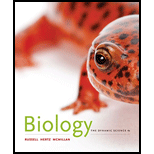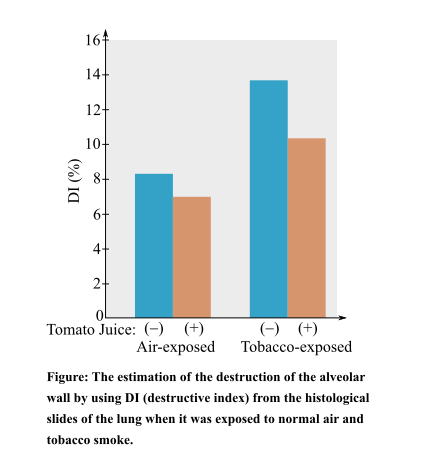
Biology: The Dynamic Science (MindTap Course List)
4th Edition
ISBN: 9781305389892
Author: Peter J. Russell, Paul E. Hertz, Beverly McMillan
Publisher: Cengage Learning
expand_more
expand_more
format_list_bulleted
Question
Chapter 46, Problem 2ITD
Summary Introduction
To review:
Whether the data given below suggest the protective effect of lycopene against tobacco’s effect. The data are represented by the graph shown below:

Introduction:
Lycopene is a carotenoid pigment found in tomatoes, carrots, watermelons, and papayas. It is a good source of vitamin C and is a powerful antioxidant. It is assumed to impart benefits by protecting against different types of cancers.
Expert Solution & Answer
Trending nowThis is a popular solution!

Students have asked these similar questions
If you had an unknown microbe, what steps would you take to determine what type of microbe (e.g., fungi, bacteria, virus) it is? Are there particular characteristics you would search for? Explain.
avorite Contact
avorite Contact
favorite Contact
୫
Recant Contacts
Keypad
Messages
Pairing
ง
107.5
NE
Controls
Media Apps Radio
Nav Phone
SCREEN
OFF
Safari File Edit View History Bookmarks Window Help
newconnect.mheducation.com
M Sign in...
S The Im...
QFri May 9 9:23 PM
w The Im...
My first....
Topic:
Mi Kimberl
M Yeast F
Connection lost! You are not connected to internet
Sigh in...
Sign in...
The Im...
S Workin...
The Im.
INTRODUCTION
LABORATORY SIMULATION
Tube 1
Fructose)
esc
- X
Tube 2
(Glucose)
Tube 3
(Sucrose)
Tube 4
(Starch)
Tube 5
(Water)
CO₂ Bubble Height (mm)
How to Measure
92
3
5
6
METHODS
RESET
#3
W
E
80
A
S
D
9
02
1
2
3
5
2
MY NOTES
LAB DATA
SHOW LABELS
%
5
T
M dtv
96
J:
ப
27
כ
00
alt
A
DII
FB
G
H
J
K
PHASE 4:
Measure gas bubble
Complete the following steps:
Select ruler and place next to tube
1. Measure starting height of gas
bubble in respirometer 1. Record in
Lab Data
Repeat measurement for tubes 2-5
by selecting ruler and move next to
each tube. Record each in Lab
Data…
Ch.23
How is Salmonella able to cross from the intestines into the blood?
A. it is so small that it can squeeze between intestinal cells
B. it secretes a toxin that induces its uptake into intestinal epithelial cells
C. it secretes enzymes that create perforations in the intestine
D. it can get into the blood only if the bacteria are deposited directly there, that is, through a puncture
—
Which virus is associated with liver cancer?
A. hepatitis A
B. hepatitis B
C. hepatitis C
D. both hepatitis B and C
—
explain your answer thoroughly
Chapter 46 Solutions
Biology: The Dynamic Science (MindTap Course List)
Ch. 46.1 - Distinguish between the roles of the respiratory...Ch. 46.1 - What is an advantage of water over air as a...Ch. 46.2 - What advantages do gills confer on a...Ch. 46.2 - Prob. 2SBCh. 46.2 - Prob. 3SBCh. 46.2 - Distinguish between positive pressure breathing...Ch. 46.3 - Prob. 1SBCh. 46.3 - Prob. 2SBCh. 46.3 - Prob. 3SBCh. 46.4 - Explain the role of hemoglobin in gas exchange.
Ch. 46.4 - Prob. 2SBCh. 46.5 - What are the key evolutionary adaptations that...Ch. 46 - Prob. 1TYKCh. 46 - Prob. 2TYKCh. 46 - Prob. 3TYKCh. 46 - Prob. 4TYKCh. 46 - Prob. 5TYKCh. 46 - Prob. 6TYKCh. 46 - Prob. 7TYKCh. 46 - Oxygen enters the blood in the lungs because...Ch. 46 - Prob. 9TYKCh. 46 - Prob. 10TYKCh. 46 - Prob. 11TYKCh. 46 - Prob. 12TYKCh. 46 - Prob. 13TYKCh. 46 - Prob. 14TYKCh. 46 - Prob. 15TYKCh. 46 - Lycopene, which is abundant in tomatoes, is...Ch. 46 - Prob. 2ITD
Knowledge Booster
Learn more about
Need a deep-dive on the concept behind this application? Look no further. Learn more about this topic, biology and related others by exploring similar questions and additional content below.Similar questions
- Ch.21 What causes patients infected with the yellow fever virus to turn yellow (jaundice)? A. low blood pressure and anemia B. excess leukocytes C. alteration of skin pigments D. liver damage in final stage of disease — What is the advantage for malarial parasites to grow and replicate in red blood cells? A. able to spread quickly B. able to avoid immune detection C. low oxygen environment for growth D. cooler area of the body for growth — Which microbe does not live part of its lifecycle outside humans? A. Toxoplasma gondii B. Cytomegalovirus C. Francisella tularensis D. Plasmodium falciparum — explain your answer thoroughlyarrow_forwardCh.22 Streptococcus pneumoniae has a capsule to protect it from killing by alveolar macrophages, which kill bacteria by… A. cytokines B. antibodies C. complement D. phagocytosis — What fact about the influenza virus allows the dramatic antigenic shift that generates novel strains? A. very large size B. enveloped C. segmented genome D. over 100 genes — explain your answer thoroughlyarrow_forwardWhat is this?arrow_forward
- Molecular Biology A-C components of the question are corresponding to attached image labeled 1. D component of the question is corresponding to attached image labeled 2. For a eukaryotic mRNA, the sequences is as follows where AUGrepresents the start codon, the yellow is the Kozak sequence and (XXX) just represents any codonfor an amino acid (no stop codons here). G-cap and polyA tail are not shown A. How long is the peptide produced?B. What is the function (a sentence) of the UAA highlighted in blue?C. If the sequence highlighted in blue were changed from UAA to UAG, how would that affecttranslation? D. (1) The sequence highlighted in yellow above is moved to a new position indicated below. Howwould that affect translation? (2) How long would be the protein produced from this new mRNA? Thank youarrow_forwardMolecular Biology Question Explain why the cell doesn’t need 61 tRNAs (one for each codon). Please help. Thank youarrow_forwardMolecular Biology You discover a disease causing mutation (indicated by the arrow) that alters splicing of its mRNA. This mutation (a base substitution in the splicing sequence) eliminates a 3’ splice site resulting in the inclusion of the second intron (I2) in the final mRNA. We are going to pretend that this intron is short having only 15 nucleotides (most introns are much longer so this is just to make things simple) with the following sequence shown below in bold. The ( ) indicate the reading frames in the exons; the included intron 2 sequences are in bold. A. Would you expected this change to be harmful? ExplainB. If you were to do gene therapy to fix this problem, briefly explain what type of gene therapy youwould use to correct this. Please help. Thank youarrow_forward
- Molecular Biology Question Please help. Thank you Explain what is meant by the term “defective virus.” Explain how a defective virus is able to replicate.arrow_forwardMolecular Biology Explain why changing the codon GGG to GGA should not be harmful. Please help . Thank youarrow_forwardStage Percent Time in Hours Interphase .60 14.4 Prophase .20 4.8 Metaphase .10 2.4 Anaphase .06 1.44 Telophase .03 .72 Cytukinesis .01 .24 Can you summarize the results in the chart and explain which phases are faster and why the slower ones are slow?arrow_forward
- Can you circle a cell in the different stages of mitosis? 1.prophase 2.metaphase 3.anaphase 4.telophase 5.cytokinesisarrow_forwardWhich microbe does not live part of its lifecycle outside humans? A. Toxoplasma gondii B. Cytomegalovirus C. Francisella tularensis D. Plasmodium falciparum explain your answer thoroughly.arrow_forwardSelect all of the following that the ablation (knockout) or ectopoic expression (gain of function) of Hox can contribute to. Another set of wings in the fruit fly, duplication of fingernails, ectopic ears in mice, excess feathers in duck/quail chimeras, and homeosis of segment 2 to jaw in Hox2a mutantsarrow_forward
arrow_back_ios
SEE MORE QUESTIONS
arrow_forward_ios
Recommended textbooks for you
 Biology: The Dynamic Science (MindTap Course List)BiologyISBN:9781305389892Author:Peter J. Russell, Paul E. Hertz, Beverly McMillanPublisher:Cengage Learning
Biology: The Dynamic Science (MindTap Course List)BiologyISBN:9781305389892Author:Peter J. Russell, Paul E. Hertz, Beverly McMillanPublisher:Cengage Learning Human Physiology: From Cells to Systems (MindTap ...BiologyISBN:9781285866932Author:Lauralee SherwoodPublisher:Cengage Learning
Human Physiology: From Cells to Systems (MindTap ...BiologyISBN:9781285866932Author:Lauralee SherwoodPublisher:Cengage Learning Human Biology (MindTap Course List)BiologyISBN:9781305112100Author:Cecie Starr, Beverly McMillanPublisher:Cengage Learning
Human Biology (MindTap Course List)BiologyISBN:9781305112100Author:Cecie Starr, Beverly McMillanPublisher:Cengage Learning

Biology: The Dynamic Science (MindTap Course List)
Biology
ISBN:9781305389892
Author:Peter J. Russell, Paul E. Hertz, Beverly McMillan
Publisher:Cengage Learning


Human Physiology: From Cells to Systems (MindTap ...
Biology
ISBN:9781285866932
Author:Lauralee Sherwood
Publisher:Cengage Learning



Human Biology (MindTap Course List)
Biology
ISBN:9781305112100
Author:Cecie Starr, Beverly McMillan
Publisher:Cengage Learning
Cancer Types SIMPLY explained! MEMORIZE them QUICKLY and EASILY!; Author: CancerEdInstitute;https://www.youtube.com/watch?v=dEBi-yvSWmQ;License: Standard Youtube License